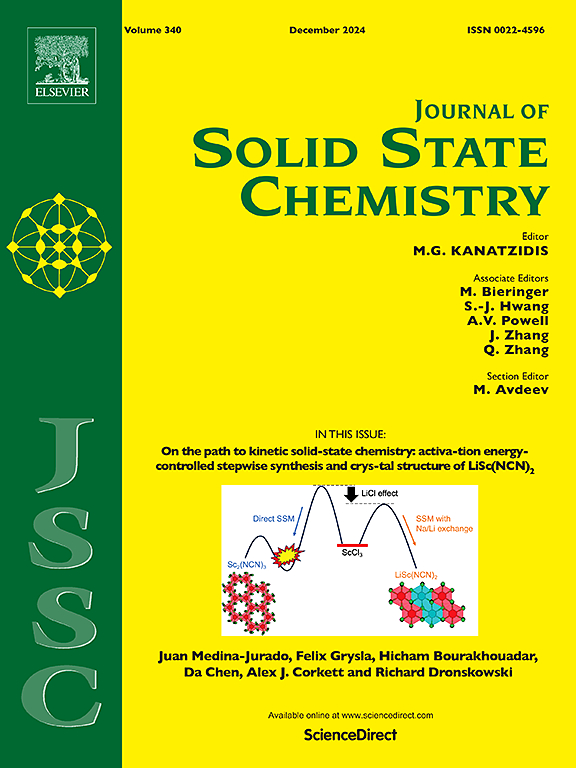The fabrication of novel Cu2(NO3)(OH)3/g-C3N4 catalyst for the thermal decomposition of ammonium perchlorate
IF 3.2
3区 化学
Q2 CHEMISTRY, INORGANIC & NUCLEAR
引用次数: 0
Abstract
A novel Cu2(NO3)(OH)3/g-C3N4 catalyst (BCN:MCN) is synthesized via a facile urea-assisted hydrothermal precipitation method for enhancing the thermal decomposition of ammonium perchlorate (AP). The as-fabricated BCN/MCN (1:1) catalyst exhibited superior catalytic activity than CuO, which reduced the high-temperature decomposition (HTD) peak of AP from 424.5 °C to 315.9 °C. The results of characterizations revealed that the introduction of MCN supports suppressed the crystallization of CuO and contributed to the deposition of block copper-based BCN on its surface, and the morphology of composite catalyst could be regulated by controlling the ratio of Cu(NO3)2·3H2O and urea. Notably, the flower-like BCN nanostructures were uniformly anchored on the MCN surface in the BCN/MCN (1:1) composite catalyst, which displayed a larger BET surface area (6.0 m2/g) and pore volume (0.019 cm3/g) than CuO catalyst. Furthermore, the incorporation of BCN enriched surface Cu+ species and elevated the active oxygen ratio (Oβ/(Oα+Oβ+Oγ) to 60.2 %, thereby synergistically enhancing the redox activity of composite catalyst. Finally, kinetic studies demonstrated a 27.5 % reduction in activation energy (Ea) of AP thermal decomposition (from 194.9 kJ/mol to 141.3 kJ/mol) with 2 wt% BCN/MCN (1:1) loading, attributed to the accelerated electron transfer and nitric acid-assisted NH3 oxidation, and a proton-electron transfer mechanism was proposed for AP thermal decomposition under the action of Cu2(NO3)(OH)3/g-C3N4 catalyst.

高氯酸铵热分解新型Cu2(NO3)(OH)3/g-C3N4催化剂的制备
采用尿素辅助水热沉淀法合成了一种新型Cu2(NO3)(OH)3/g-C3N4催化剂(BCN:MCN),以促进高氯酸铵(AP)的热分解。制备的BCN/MCN(1:1)催化剂表现出比CuO更好的催化活性,将AP的高温分解(HTD)峰从424.5℃降低到315.9℃。表征结果表明,MCN载体的引入抑制了CuO的结晶,促进了块状铜基BCN在其表面的沉积,并且可以通过控制Cu(NO3)2·3H2O与尿素的比例来调节复合催化剂的形貌。值得注意的是,在BCN/MCN(1:1)复合催化剂中,花状BCN纳米结构均匀地锚定在MCN表面,比CuO催化剂具有更大的BET表面积(6.0 m2/g)和孔体积(0.019 cm3/g)。BCN的掺入使表面Cu+富集,使活性氧比(Oβ/(Oα+Oβ+Oγ))提高到60.2%,从而协同增强了复合催化剂的氧化还原活性。最后,动力学研究表明,当BCN/MCN为2 wt%(1:1)时,AP热分解的活化能(Ea)降低了27.5%(从194.9 kJ/mol降至141.3 kJ/mol),这是由于加速了电子转移和硝酸辅助NH3氧化,并提出了Cu2(NO3)(OH)3/g-C3N4催化剂作用下AP热分解的质子-电子转移机理。
本文章由计算机程序翻译,如有差异,请以英文原文为准。
求助全文
约1分钟内获得全文
求助全文
来源期刊

Journal of Solid State Chemistry
化学-无机化学与核化学
CiteScore
6.00
自引率
9.10%
发文量
848
审稿时长
25 days
期刊介绍:
Covering major developments in the field of solid state chemistry and related areas such as ceramics and amorphous materials, the Journal of Solid State Chemistry features studies of chemical, structural, thermodynamic, electronic, magnetic, and optical properties and processes in solids.
 求助内容:
求助内容: 应助结果提醒方式:
应助结果提醒方式:


